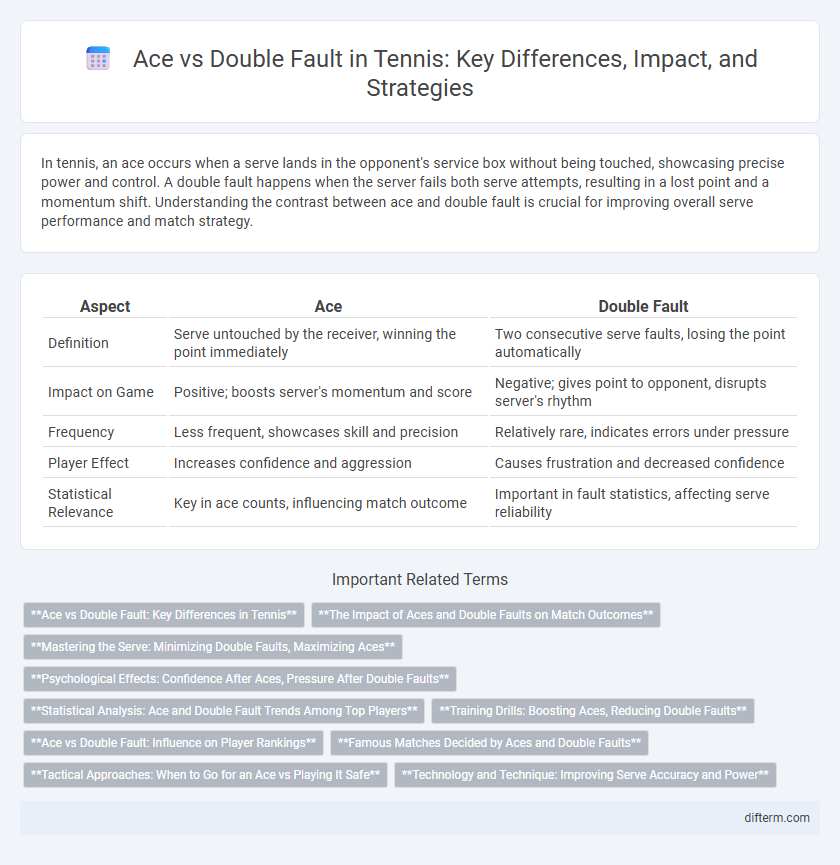In tennis, an ace occurs when a serve lands in the opponent's service box without being touched, showcasing precise power and control. A double fault happens when the server fails both serve attempts, resulting in a lost point and a momentum shift. Understanding the contrast between ace and double fault is crucial for improving overall serve performance and match strategy.
Table of Comparison
| Aspect | Ace | Double Fault |
|---|---|---|
| Definition | Serve untouched by the receiver, winning the point immediately | Two consecutive serve faults, losing the point automatically |
| Impact on Game | Positive; boosts server's momentum and score | Negative; gives point to opponent, disrupts server's rhythm |
| Frequency | Less frequent, showcases skill and precision | Relatively rare, indicates errors under pressure |
| Player Effect | Increases confidence and aggression | Causes frustration and decreased confidence |
| Statistical Relevance | Key in ace counts, influencing match outcome | Important in fault statistics, affecting serve reliability |
Ace vs Double Fault: Key Differences in Tennis
An ace in tennis occurs when a player's serve lands in the service box and is untouched by the opponent, showcasing precision and power. A double fault happens when the server fails to get either of two serve attempts into the correct service box, resulting in an immediate point loss. The key difference lies in the successful serve execution for an ace, while double faults reflect service errors that can shift momentum in a match.
The Impact of Aces and Double Faults on Match Outcomes
Aces significantly boost a player's winning probability by delivering unreturnable serves that directly earn points, often shifting match momentum in their favor. Conversely, double faults result in lost points and can undermine a player's confidence, increasing pressure during critical junctures of the match. Statistical analyses reveal that higher ace rates correlate with match victories, while frequent double faults often contribute to losses, underscoring their impact on final outcomes.
Mastering the Serve: Minimizing Double Faults, Maximizing Aces
Mastering the serve requires precise technique and consistent practice to maximize aces while minimizing double faults, key indicators of serve effectiveness in tennis. Developing a reliable toss, optimal racket speed, and strategic placement enhances serve accuracy and power, reducing the risk of double faults. Professional players often analyze serve patterns and adapt their tactics to maintain a high ace count and limit serve errors during matches.
Psychological Effects: Confidence After Aces, Pressure After Double Faults
Aces in tennis significantly boost a player's confidence, reinforcing aggressive play and psychological dominance over the opponent. Conversely, double faults increase pressure, often triggering self-doubt and negatively impacting focus during critical points. Managing these psychological effects is crucial for maintaining composure and performance under high-stakes conditions.
Statistical Analysis: Ace and Double Fault Trends Among Top Players
Statistical analysis of ace and double fault trends among top tennis players reveals that elite athletes average approximately 7 to 12 aces per match, with ace rates often exceeding 10% of their total serves. In contrast, double fault percentages typically range between 2% and 5%, directly impacting player efficiency and match outcomes. Data from ATP and WTA tours show that players with higher ace counts correlate with increased serve dominance, while those with elevated double fault frequencies often experience greater pressure during crucial points.
Training Drills: Boosting Aces, Reducing Double Faults
Training drills targeting precision serve placement and consistent toss mechanics significantly boost ace rates while minimizing double faults. Practicing serves under simulated pressure conditions enhances muscle memory and improves mental focus, reducing unforced errors. Incorporating video analysis and targeted feedback accelerates technical adjustments, leading to more reliable serve performance and increased point-winning aces.
Ace vs Double Fault: Influence on Player Rankings
Aces significantly boost a player's statistics by demonstrating superior serving skills, often resulting in higher ATP or WTA rankings due to their direct impact on winning points. Double faults, conversely, negatively affect player rankings by increasing unforced errors and reducing match-winning probabilities, leading to a loss of crucial ranking points. The balance between aces and double faults influences overall service efficiency, which is a key metric used by ranking algorithms to evaluate player performance.
Famous Matches Decided by Aces and Double Faults
Famous tennis matches often hinge on the crucial difference between aces and double faults, where a single ace can shift momentum and seal victory while a critical double fault can cost key points and lead to unexpected upsets. Iconic matches like the 2008 Wimbledon final between Roger Federer and Rafael Nadal showcased how aces served as decisive weapons, whereas John Isner's marathon match at Wimbledon 2010 highlighted the dramatic impact of double faults under pressure. These moments underline the strategic importance of serving precision in elite tennis competition.
Tactical Approaches: When to Go for an Ace vs Playing It Safe
Tennis players strategically decide between aiming for an ace or avoiding double faults based on match context, opponent weaknesses, and surface conditions. Aggressive servers target aces during crucial points to gain quick advantages, while conservative serves reduce risk and maintain rally consistency. Understanding the balance between high-risk serves and consistent placement enhances overall match performance.
Technology and Technique: Improving Serve Accuracy and Power
Advanced motion-capture technology and high-speed video analysis enable players to fine-tune their serving technique by providing detailed feedback on body positioning, racket angle, and ball toss. Utilizing biomechanical sensors, athletes optimize muscle engagement and timing to balance power generation with control, reducing double faults while increasing ace rates. Incorporation of AI-driven analytics helps customize training regimens that enhance serve precision and consistency, leading to more effective and reliable serves in competitive play.
ace vs double fault Infographic

 difterm.com
difterm.com